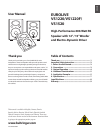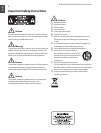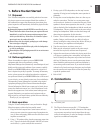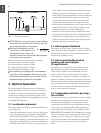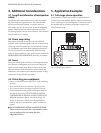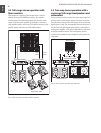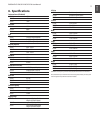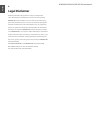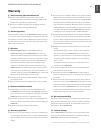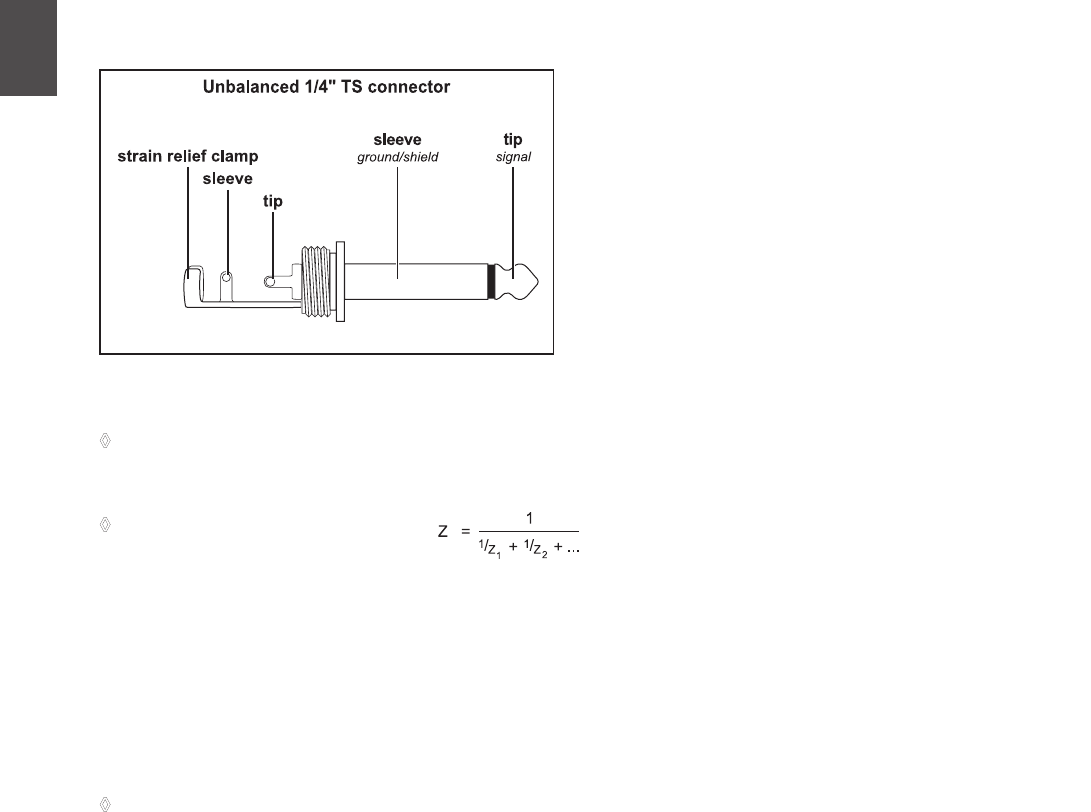
ENGLISH
EUROLIVE VS1220/VS1220F/VS1520 User Manual
4
ATTENTION: Never connect the output signals of different
◊
power amps to both parallel inputs at the same time. This
may permanently damage your equipment.
When several loudspeakers are wired
◊
in parallel, the overall impedance Z
T
to
be handled by the power amp can be
calculated, as shown here, from the individual impedance
values of the connected speakers:
For the VS series, here are typical connection scenarios:
Two 8 Ohm speakers in parallel = 4 Ohms
Four 8 Ohm speakers in parallel = 2 Ohms
Two 4 Ohm speakers in parallel = 2 Ohms
Four 4 Ohm speakers in parallel = 1 Ohm
Your amplier may be damaged if the actual impedance
◊
drops below its input impedance. Please make sure that
the calculated total impedance Z
T
is not smaller than the
minimum impedance specied for your amplier.
Optimal Operation3.
We have developed the VS series for use in a wide range of
possible applications. Of course, the sound of your loudspeak-
ers depends on the acoustic characteristics of the room/space
in which they are being used. The following chapters of this
manual will give you information about getting the most out of
your EUROLIVE loudspeakers.
Loudspeaker placement3.1
Here are some tips to get optimal sound and performance from
your loudspeaker(s):
Elevate the loudspeaker at or above head level. High frequen-•
cies are the segment of the audio spectrum responsible for
clarity and speech intelligibility. They can get mufed by the
front row of the audience, so we recommend positioning your
loudspeakers so the high-frequency drivers are slightly above
the height of the audience. The more you can get everyone in
direct earshot, the better. Imagine the loudspeaker is a giant
ashlight, and you want to illuminate everyone in the room.
Avoid placing full-range loudspeakers in a corner or right next •
to a wall. This enhances the low frequencies and can cause
the sound to get muddy. Subwoofers may be placed almost
anywhere since low frequencies are not highly directional.
Make sure that the loudspeakers are not in a place where they •
could be knocked over by dancing audience members, overly
eccentric stage performers, sudden earthquakes, etc.
Some rooms, such as gymnasiums and auditoriums, create a •
large amount of natural reverb, making it difcult to maintain
intelligible sound. Laying carpet or rugs on the ground and
curtains across windows or brick walls will help dampen the
reections and improve the overall sound.
How to prevent feedback3.2
Always place the “front of house” speakers ahead of the micro-
phones (from the audience’s perspective), and never behind. Use
professional oor monitors or an in-ear monitoring system to
allow the stage performers to hear.
How to avoid feedback when 3.3
working with record players
(DJ applications)
In applications with record players, bass feedback can occur.
Bass feedback occurs when low frequencies get back to the
pickup and are reproduced on the loudspeakers. The most
common causes for this are: speakers located too closely to
the record player, a room with a wooden oor, or presence of a
podium or a platform. In such cases, it is best to move the loud-
speakers away from the record player and remove them from the
stage, so that they are located on rm ground. Another option
is to use raised stands, which prevent the loudspeakers from
having a direct contact with the ground.
Loudspeaker protection by using a 3.4
low-cut filter
Try to prevent damage to your loudspeakers caused by extreme
oscillation of the low-frequency driver due to subsonic noise
and extremely deep frequencies. Use an equalizer to cut off
those frequencies that fall below your loudspeakers’ frequency
range, or use a low-cut/high-pass lter. Most equalizers and
sound-improvement systems offer a low-cut function, like the
BEHRINGER ULTRAGRAPH DIGITAL DEQ1024, for example.
Using a low-cut lter in your signal path is particularly recom-
mended if you use record players or CD players as your signal
source. CD players often produce extremely deep frequencies,
which can lead to extreme excursions of the low-frequency
driver.
Fig. 2.3 ¼" TS loudspeaker connector
T



